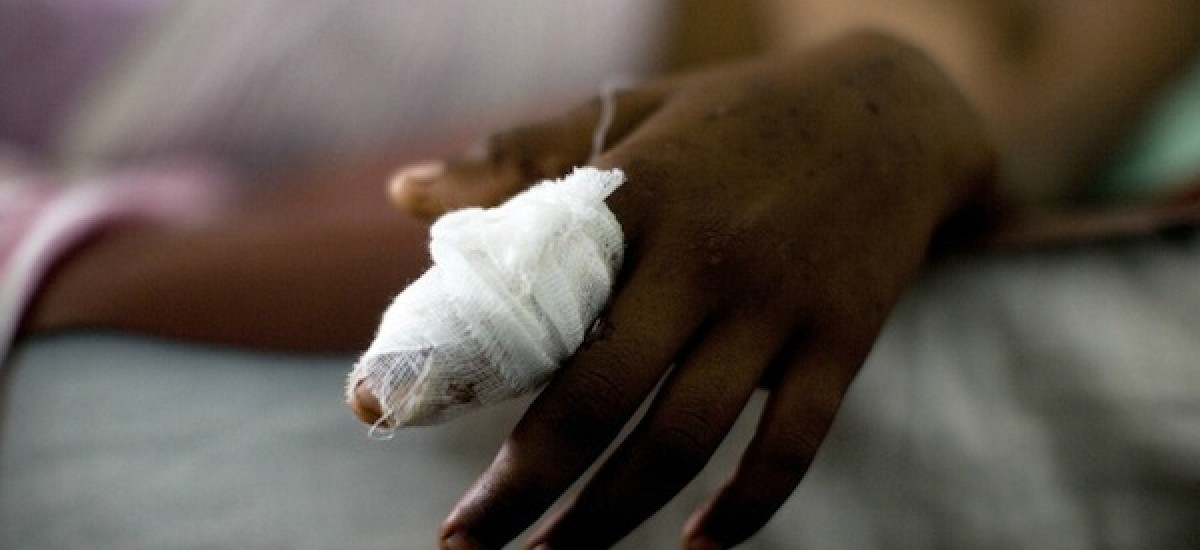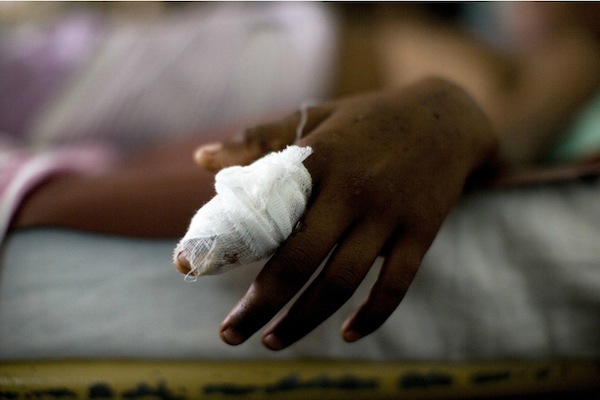Image courtesy Ron Haviv’s photo essay The Fires Within: The Sri Lankan Civil War
For many in Sri Lanka and around the globe, war is generic. Images of war victims are anonymous and nonspecific. If the caption on a photograph of a child war victim is altered, the meaning of the image can be changed and the photo reused in different contexts and by different parties – by LTTE advocates, different political factions, or by the Sri Lankan government. Do photographs of war victims necessarily vivify the condemnation of war? No. The same photograph that can be used as a call for peace can be used as a cry for revenge, as exaltation of a warring party, as acknowledgement that terrible things happen, or even as intimation that terrible things will continue to happen. The uses of the same Sri Lankan war footage can be diverse, from the promotion of the military, to appeals for peace, to ammunition for Human Rights activists. While photographs have a creator and so represent the view of someone, photographer intent does not necessarily determine the meaning of a photograph – processed images take on a life of their own depending on what context they are viewed in, and by whom. How a photograph is understood depends on the organizing idea, the moment, the place, the uses and the identification of the picture. So what should we take a photograph to mean? It might seem that photographs are simply a crude statement of fact addressed to the eye. But this belief is misleading and outdated. Photographs, as evidenced by their numerous adaptable uses are both objective record and personal testimony, a faithful copy or transcription of reality and an interpretation of that reality.
Today’s news media provides us with a constant stream of images, and within that image hyper-saturated influx it is easy to see that images that should have some profound impact upon our consciences have a diminishing effect. As early as the 1800s it was suggested that we gradually become habituated to the diet of terrors by which we are surrounded, the process of overstimulation acts to blunt the discriminating powers of the mind and reduce it to a state of almost savage torpor. Unless in a gallery or museum, we hardly take the time to view a photograph outside the media surround in which it first occurs. While photographs actualize the facts we read in news stories, they are employed to evoke some kind of emotional response in the viewer. But in a culture and society that is frequent witness of gruesome homegrown imagery, such as those of the 27-year civil war, we are losing our capacity to react. Sri Lankan society is becoming habituated and desensitized to the quotidian accounts of rape, abuse and murder occurring at her very doorstep.
Perhaps the root of what is often regarded as spectator inactivity is the intense level of acceptable violence and sadism in mass culture. Or perhaps it is Sri Lankan habituation to horror in real life that desensitizes Sri Lankans to the horror of certain images. If one feels that there is nothing the indeterminate “we” or “they” can do, one begins to get bored, cynical, apathetic. Compassion needs to be translated into action, or it dissolves. This is perhaps why clips of war crimes, framed within the Channel Four documentary “Killing Fields”, have been so affecting. Much of the cellular video footage incorporated into the documentary was available for viewing long before “Killing Fields” was released, but it only created sizeable controversy in the context of a documentary urging proactive change. The frustration of not being able to do anything about what images show may be translated into an accusation of the indecency of regarding such images. The sheer inability of many of us to ‘do’ anything about the brutality -compassion withering into frustration- and suddenly it became easier to deny that war crimes were committed, to shift focus from the content of the imagery to trivial errors in editing, or to blame a manipulative Tamil Diaspora with hidden political intent.
Following the shock of the First World War, artists were convinced that if they extensively publicized the graphic dreadfulness of war, citizens would come to realize the horrors therein contained, and would not tread the same path again. A few years later, Europe mobilized for war again, WW1 lessons were unlearned and popular photographic works renouncing war like Kreig dem Kreig! (War against War!) by Ernst Freidrich became nothing but evidence of the limited power of art to ‘make the real more real’. If photographs cannot altogether prevent wars, they can certainly act as reminder for why war and violence should rightly be a last resort. For example, the photograph below, removed from the media context of the newspaper in which it was originally published, is in Sri Lankan culture, iconic – representative of decades of ethnic conflict.
A scene at Borella junction on 25th July 1983, taken by Chandraguptha Amarasinghe, the photograph depicts a naked Tamil youth being bullied by a group of men and forms part of Sri Lankan public memory of the 1983 genocide. Photographs such as the one above are important because they signify that people want to revisit the past, they want to access history through images, they want to remember. Photos eventually act as a form of social/moral instruction, they remind us of atrocities of the past which we must take pains to avoid repeating and recall momentous instances in history that have come to channel our present day lives. Another argument for why we are obliged now, more than ever before, to discern what photography we deem important, is because in this post-war period we are in the process of creating an archive of memories; photographs that will be remembered in times to come, photographs along with their sentiment that will inform our understanding of the 27 year civil war, and photographs that will instruct us of what atrocities can occur but must be avoided at all costs.
Not all reactions to pictures are under the supervision of reason and conscience. Therefore, one should think about the capacity to assimilate what photographs might show. Why does highway traffic slow down going past a terrible car crash? Curiosity? Is it the wish to see something gruesome? Why do we read accounts of fires and murders in the papers? Is it to fortify oneself against weakness? To inure one-self against suffering? To simply acknowledge the existence of the irredeemable? Perhaps it is a space of transfiguration. After all, a view of suffering is deeply rooted in religious thinking where pain is linked to sacrifice and sacrifice to exaltation (statues and images of Christ crucified, for example, are commonly considered holy or symbols of transfiguration). In other religious spheres, suffering might be linked to the inevitable, unavoidable or even the morally warranted and is used as a reminder of our moral duties – here imagery of suffering serves as a form of moral-compass. Whether we are drawn to the imagery of suffering because we believe it provides us with a form of moral guidance, is a space of transfiguration, allows us to form psychological defenses or simply satisfies our curiosity, it is important for each of us to critically asses our particular relations to images of suffering, before we can begin to understand our reactions to them.
Whether or not we are able to act on our initial reactions, or understand why it is we are drawn to gruesome imagery, or in some cases repelled away from this imagery, to view images and to think about images of war is a way to avoid passivity. In that sense it is necessary, not only to think about how, for example, the Channel Four documentary sanitizes or falsifies the conflict it is supposed to be documenting, but also to ask what atrocities are not being shown. To photograph is for someone to selectively choose what to photograph from the infinite medley of what not to photograph. It is important, therefore, that the reader consider what is photographed, what has not been photographed (for instance due to government constraints on media in Sri Lanka) or what cannot be photographed (according to a UN report Sri Lanka had the second highest number of disappeared people in the world in 2006). What do self-policed television news producers, newspaper and magazine editors leave out for ‘good taste’? Of the 300,000 civilians trapped in the war zone, how many could be photographed? Of the camera-phones that took photographs, how many survived the last stages of the war so their photos could be exposed? In this regard, I believe it is important that the viewer think proactively not only about how photography is interpreted, but how and why it is produced. What are the constraints on photography at a given time (foreign journalists were not allowed in the war zone in 2009), how did these constraints shape photography that was finally produced (were photographs taken by amateurs or professionals? By commissioned “officials”?) and how were these photographs taken (by digital camera or phone? Were they staged or candid?) ?
By pausing to think about the ways in which photographs are manipulated, we are less prone to react in a predetermined way to those photographs. There are many questions that surround photography, and thus thinking about imagery has great potential to be proactive and interactive. Pausing to think and criticize prevents the viewer from hastily dismissing photography as ‘indecent’, from forming quick conclusions or immediately adopting hostile attitudes towards those who create and exhibit photography.
Furthermore, it is the first step towards creating a healthy discourse on photography. To prevent that state of passivity that is ascribed to those overwhelmed with macabre imagery it is necessary to think critically of the motive of the photographer, of what has been excluded by the act of photography, of our own personal relations to imagery of suffering, and of the photographic traditions which cultivate our social memories. In thinking about war photography and coming to appreciate what imagery is important to us, we are in the process not only of undermining those who wish to dictate the meaning of photographs, but we are also in the process of selecting for posterity the images that will be recalled of genocides, ethnic conflict and the 27 year civil war. Hopefully these will be images that inform them of past atrocities and their causes, and consequently guide them on alternate paths towards understanding, forgiveness and reconciliation.


